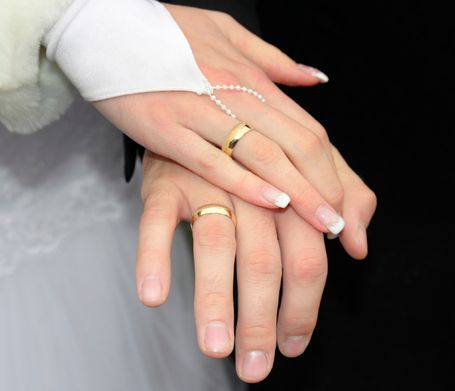
Wedding Rings
History of the Wedding Rings
Where did the tradition of wedding rings come from?
The first wedding rings can be traced back to the Ancient Egyptians when they exchanged rings made from braided reeds and hemp. They placed these rings on the fourth finger of the left-hand as they believed that there was a 'vein of love' that ran from this finger directly to your heart.
Almost 5000 years ago, ancient Egypt was the first known culture where people would exchange "rings of love" often made of woven reeds or leather. It is said that the Egyptians saw the ring, a circle, as a powerful symbol. The band with no end representing eternal life and love, and its opening representing a gateway to worlds unknown. Rings were highly regarded in their culture, especially scarabs and signets.
Signet rings, used as a personal signature, continued to be used by the Greeks and Romans. It is said that the signet inspired some of the earliest known betrothal rings in Rome. Yes, in Egypt they exchanged rings as gifts of devotion, then in Greece they gave rings to lovers featuring Eros the god of love or his cherubs. But it is believed that it was the Romans who linked the ring to marriage. Most commonly with a "fede" ring, depicting two hands clasping in love or agreement/ dextrarum iunctio. These designs could be made in solid gold or carved in stone, like a signet, often in cornelian, aquamarine, garnet, or onyx.
The Western traditions of wedding rings can be traced to ancient Rome and Greece, and were first associated with the marital dowry and later with a promise of fidelity. The modern exchange of rings derived from the customs of Europe in the Middle Ages as part of Christendom.
Wedding rings symbolise eternal love and commitment within a relationship. This emblem of love is exchanged between two people on their wedding day and worn to show the world they are married. During the wedding service, the couple will say their vows to each other while exchanging rings.
Why do people wear wedding rings on right hand?
This is because it is believed that the right hand represents virtue and honor, just as the Bible mentions Jesus sitting at the right hand of God. In Jewish tradition, during the wedding ceremony, the wedding ring is placed on the index finger of the right hand.
Fede rings, in different styles, were popular in Europe for over a thousand years. They resurfaced in the 1100s and lasted for centuries. Over the years they became much more intricate with interlocking bands and ornate enameling. Most commonly still worn today is the Irish Claddagh ring, two hands holding a heart with a crown. The Claddagh ring was first designed in the 16th century, thirteen centuries after the original fede rings of Rome.
It is a long standing Jewish tradition that the wedding band must be an unbroken circle of solid gold or silver representing an everlasting marriage. With no stones or details representing a marriage free of distraction or complication. The minimum value is said to be a penny this low value represents that their intentions are true and not driven by money or false pretense. The lesser known is the past tradition of the Jewish ceremonial marriage ring. Dating back at least to the 10th century and used through the 19th century, becoming more intricate over time with filigree and enamel. Often the roof, thought to represent the couples' home or temple, opened like a locket to reveal a Hebrew inscription. Since these rings were so ornate they were most likely shared for all of the weddings within a town. There are many different opinions on the meaning and purpose behind these ornate rings that grooms offered their bride during the ceremony, unfortunately there is very little documentation preserved about these rings.
Today many people know De Beers’ to be behind the diamond ring, while it is true that they popularized it as an engagement ring, diamonds had indeed already been used in love rings for several centuries. The first known diamond ring was actually from the late 100sAD found in Rome, an uncut diamond ring belonging to a young girl. However there is no way to know it if was a gift of love, a symbol of status or any other type of ring. Early on it was known that diamonds were strong and considered valuable, but it wasn't until many centuries later that they had the tools to cut them and reveal their sparkle.
In the 15th century a gift of jewelry was often sent from the father of the bride to father of the groom, proposing the intent to marry off his daughter. It was not uncommon for this gift to be a diamond ring, in a way, marking the beginning of the diamond engagement ring.
The first documented diamond betrothal ring was in 1475 at the wedding of Costanzo Sforza and Camilla D'Aragona in Italy. Their wedding poem read “Two wills, two hearts, two passions are bonded in one marriage by a diamond”
By the 17th century diamonds were showing up more often in wedding and engagement rings. At this time the diamond could be given from the man to woman or woman to man as a pledge of love. In the Georgian era of the 18th century when simple posy rings were still widely used as wedding bands it became popular for women to wear 'keeper' rings on either side of her wedding band to accent and protect it. These rings were commonly made of rose cut diamonds set in silver and gold, similar to today's eternity band.
'Keeper' Ring, gold, silver, rose cut diamonds. 18th Century. Source: Unknown
Diamond engagement rings grew in popularity over the 19th century, but did not become the norm until De Beers' launched their "Diamond is Forever". Today a diamond engagement ring is still the most common choice, however many couples now opt for unique styles, vintage pieces, rough diamonds, or non traditional stones. Other couples are interested in more eco friendly options including lab grown diamonds and moissanites, or recycled diamonds. Some women decide to forgo the engagement ring all together, while some men now choose to wear engagement rings along with their partners. Historically this is such an interesting time since people have started creating their own traditions.
Throughout history while the ideas of marriage changed along with the styles of the rings that represented it, the ring finger also changed. Weddings rings have been documented to be worn on every finger, even the thumb. Today it is most commonly worn on the forth finger of the left hand, but some countries and cultures do it differently. Most notably moving the engagement ring to the right hand after the wedding or the reverse. But how did the forth finger become known as the ring finger? Well that goes back to the Egyptians again (...or early Romans depending on who you ask.) They are said to have believed that the forth finger had a vein or nerve that connected directly to the heart. And while there is not a bit of scientific evidence to support it, we returned to that tradition out of pure sentiment. Which is my favorite part of the wedding ring's story.
.
We need your consent to load the translations
We use a third-party service to translate the website content that may collect data about your activity. Please review the details in the privacy policy and accept the service to view the translations.

